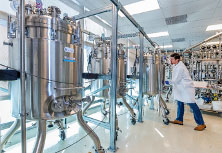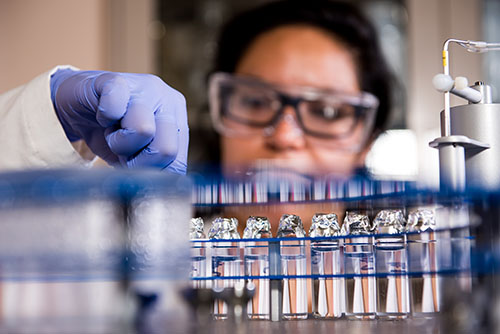
Photo credit: Andrea Starr | Pacific Northwest National Laboratory
When thinking about implementing a Smart Labs program, it is important to know the occupants and the research performed in lab spaces. Researcher safety is the utmost priority in any Smart Labs program, and a first step to ensuring their safety is through effective engagement and education. The following are tips for communicating with scientists that will encourage successful adoption of Smart Lab practices.
Engage Scientists and Researchers Early
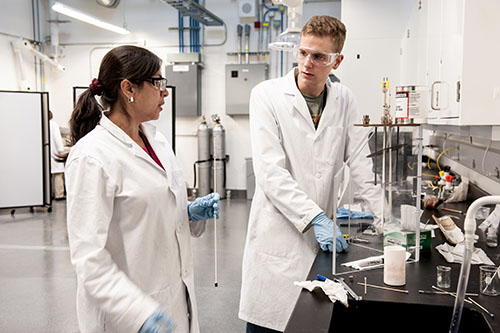
Photo credit: Dennis Schroeder / NREL
Engaging scientists, including researchers, lab managers, new staff, technicians, and others involved in research operations, in the initial stages of the process is critical to ensure the long-term success of a Smart Labs program. An organization may do outstanding work to reduce the impact of a facility and provide researchers with a safe environment in which they can most effectively conduct their work, but ultimately it is scientists, the occupants, who dictate how the lab operates. Furthermore, not all researchers will be motivated or have the capacity to be involved in your Smart Labs program. Include scientists early in the process to:
- Inform Decisions: Researchers understand their needs better than anyone. Allow them to inform key decisions in the Smart Labs process to ensure research needs are met. Researchers may also have ideas that address issues in innovative ways.
- Build Positive Relationships: Including researchers in changes or updates made through Smart Lab measures will keep them informed throughout the process, leading to better adoption of practices that will lead to continued success of a Smart Labs program.
- Ask Questions: Inquire into as to what is not working in the lab, the comfort of the occupants, and other issues that researchers encounter. This allows Smart Lab efforts to address additional areas of improvement that would not otherwise be noticed.
Know the Lab Processes and Associated Hazards in Each Space
Get to know the processes that are performed in the lab and the hazards that may be associated with those processes by working with the scientists in each lab space under consideration.
Start by asking these questions:
- What types of processes are going on in the space?
- How long do these processes take?
- What equipment is used?
- Are there alternative methods or chemicals that achieve the same result in a safer, more resource- and energy-efficient way?
Educate Scientists About Green Labs Practices
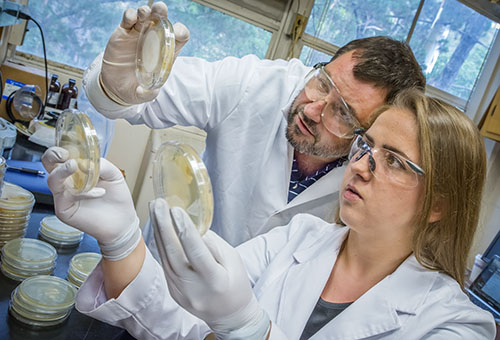
Photo credit: Berkeley Lab - Roy Kaltschmidt
Many scientists are unaware of how their behaviors determine the environmental impact of their lab, such as the amount of energy and water used or the waste generated by their experiments. The full impact of the products and chemicals they are using is not always on the forefront of a scientist's mind, whether it's upstream in the footprint of production or downstream in hazardous waste management.
By bringing awareness to the impact of the scientists' behaviors and providing them with ways they can reduce their impact, scientists become partners in Smart Labs efforts, enhancing the effects of existing efforts. Actions such as choosing to use a safer, more benign chemical in place of a hazardous one also creates safer work environments for the researchers. The Green Labs Ambassador Program is a good starting point in educating researchers.
Sustain a Culture of Resource Awareness
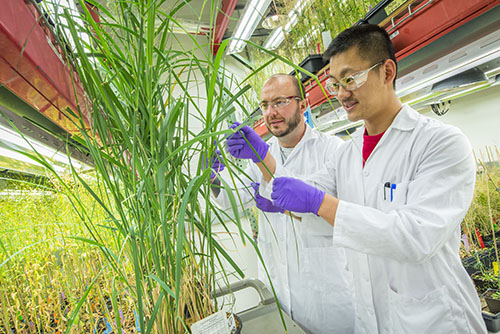
Photo credit: Berkeley Lab - Roy Kaltschmidt
All researchers want to work in safe, efficient laboratories that meet their needs and allow them to conduct high-level research. After you educate the current researchers on Green Labs practices, the efforts must be made to sustain these practices and develop a strong culture of resource awareness and sustainability for future scientists.
- Continue engaging researchers and encourage accountability for them to continue reducing the impact of the lab through better lab practices and habits.
- Provide continued training for labs as they develop and grow their staff to include new researchers.
- Implement management protocol to maintain sustainable lab practices.
- Include language about sustainable practices in offer letters and packages to incoming researchers. This helps identify potential candidates that will help facilitate an ongoing Smart Labs program and sets a standard of resource awareness from the start.
Green Lab Ambassador Program
The Green Lab Ambassador training program through My Green Lab is a resource for Smart Labs programs to facilitate engaging the scientists of each lab. The program serves as an introductory course in lab sustainability and is designed to educate scientists and laboratory professionals. The free online program is comprised of online training videos, quizzes, and monthly discussions on ways to reduce the impact of research in the following areas:
- Energy
- Waste
- Water
- Green chemistry
- Procurement.
The program can both initiate a Smart Labs program by inspiring scientists to change their behavior and support existing efforts by educating scientists on concrete actions they can take to become My Green Lab Certified.
Who Should Participate in the Green Lab Ambassador Program?
- Members of Smart Labs teams
- Anyone wishing to effectively engage scientists in reducing the environmental impact of their labs
- All members of a lab – the program is designed for researchers of all experience levels from undergraduates and graduate students to lab managers and PIs
Components of the Green Lab Ambassador Program
The Green Lab Ambassador program is composed of three educational components:
Training Videos
Four Smart Science videos follow a lab through a series of group meetings where topics related to green labs are discussed. The videos provide participants with an example of how one person in a lab can initiate an entire lab’s journey towards sustainability. These videos are intended to be watched in order and cover five main topics of lab sustainability:
Part I: Activation Energy
This video describes how to get a lab engaged with the idea of green labs and how to structure a lab meeting to include discussions about reducing the impact of the lab. This video also includes ways scientists can significantly reduce energy consumption through behavioral changes.
Part II: Rachael Goes Dumpster Diving
A continuation from Part I, this video focuses on the opportunities to reduce, reuse, and recycle in the lab without compromising laboratory safety.
Part III: Water, Water Everywhere
In the third video of the series, tactics for implementing practices presented in Parts I and II are discussed, followed by a conversation about where water consumption in a lab takes place practical ways to reduce some of these operations while maintaining research integrity.
Part IV: The Lab Bonds
The final video discusses applications for green chemistry to all types of research. It also shares how a lab can continue their sustainability efforts by becoming My Green Lab Certified. The video ends with a conversation about sustainable procurement.
Quizzes
After watching each video, participants are asked to take a quiz related to the material that will provide participants with a knowledge check. The scores from the four videos will be compiled into a total score; participants must receive a score of 80% or higher to become a Green Lab Ambassador. Green Lab Ambassadors will receive a certificate for their successful completion of the Green Lab Ambassador training program.
Webinars
After watching the videos, participants will be added to a Microsoft Teams Channel where they can engage in an open-discussion webinar hosted on the first Friday of each month. During this webinar, participants are encouraged to discuss the material in the videos, ask questions, and share their own experiences in making the changes suggested in the videos to reduce their impact. The channel is designed to continue participants’ education and create a network of resources and Green Lab Ambassadors – participants will be able to chat with other ambassadors and engage the My Green Lab team at any time.
Participants in the Green Lab Ambassador program will be asked to complete all of the training videos and associated quizzes to ensure they have fully understood the material presented and how to apply it to their labs. The webinars are not required to receive the ambassador certificate; however, they provide invaluable resources and updates from the green labs community.
Green Chemistry
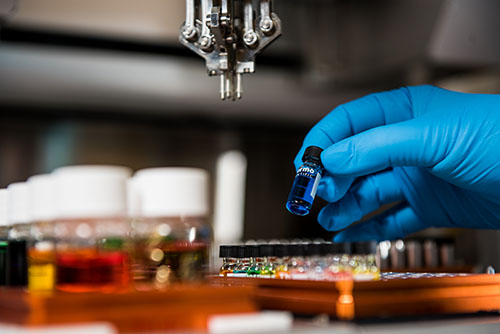
Photo credit: Andrea Starr | Pacific Northwest National Laboratory
Green Chemistry is not a subdiscipline of chemistry, like organic or inorganic, but rather a set of principles aimed at improving human health and the lab environment through the reduction of exposure to hazardous materials. The 12 Principles of Green Chemistry apply to all laboratories that use chemicals, including biology, engineering, and biophysics labs. They guide the selection of more sustainable chemicals and design of chemical products or protocols that reduce or eliminate the use and generation of hazardous substances.
The 12 Principles of Green Chemistry were developed nearly 25 years ago. Since then, several books, guides, and courses have been developed to assist researchers in choosing safer, more benign chemicals. Depending on the goal of the Smart Labs program, the starting point for implementing Green Chemistry principles varies.
| Goal | Starting Point |
|---|---|
Introduce Green Chemistry practices |
Read the 12 Principles of Green Chemistry and have a team discussion about how they apply directly to the research conducted in your lab spaces My Green Lab and Beyond Benign's Guide to Green Chemistry Experiments for Undergraduate Organic Chemistry Laboratories |
Reduce exposure to hazardous or toxic materials |
Use MilliporeSigma's DOZN Tool to identify the impact of certain chemicals. The tool scores chemicals based on the 12 principles of Green Chemistry. Solvent selection guides |
Improve experimental design for synthesis |
Use MilliporeSigma's DOZN Tool to identify the impact of certain chemicals. The tool scores chemicals based on the 12 principles of Green Chemistry. |
The tools are designed to help researchers make specific substitutions to their experimental procedures. The recommendations require researchers to evaluate the feasibility of the substations for their own experiments.
Equipment-Specific Practices to Reduce Plug Loads in Labs
Fume Hoods: Sash Management
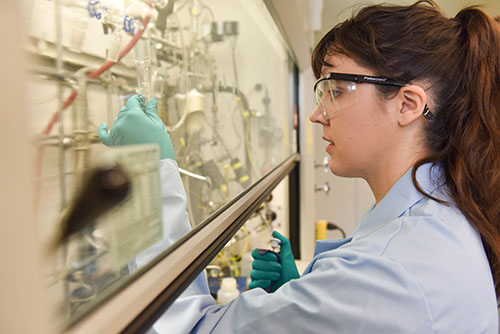
Photo credit: Andrea Starr | Pacific Northwest National Laboratory
Sash Management refers to a program aimed at helping scientists and lab members to remember to close fume hood sashes after completing work in fume hoods. Many organizations turn this program into a friendly competition between labs, awarding prizes to labs that have been most successful in remembering to close their sashes.
Why fume hoods?
A single chemical fume hood can use as much energy as 3.5 households every day due to the large volume of air that must be moved through the hood by the ventilation system. Broadly speaking, ventilation systems and fume hoods can be classified into two categories:
- Constant air volume (CAV)
- Variable air volume (VAV).
As these names suggest, in a CAV fume hood the amount of air flowing through the hood is constant, whereas in a VAV fume hood the amount of air flowing through the hood can be adjusted. Because energy consumption in fume hoods is related to the volume of air flowing through them, reducing the air flow volume in a VAV fume hood results in the greatest energy savings.
Air flow volume in a fume hood is manipulated by adjusting the height of a movable sash, which acts as a barrier between the inside of the hood and the rest of the lab. The sash should be raised when working in the hood, and in most cases the sash should be lowered when work in the hood is complete to ensure the safety of laboratory personnel. In a VAV fume hood, lowering the sash also reduces the speed of the exhaust fan and the volume of air being exhausted by the VAV ventilation system. The energy savings from lowering the sash in a VAV fume hood can be upwards of 40%.
Regardless of the type of fume hood in a lab, all fume hood sashes should remain closed to ensure the safety of laboratory occupants.
What does a sash management competition look like?
The competitions usually last three to eight weeks and involve the following steps.
- Gather baseline data of fume hood sash height positions before the competition.
- Record the sash heights in the labs one to two times a day for a week.
- Communicate the purpose and benefit of the competition and what impact the results will have.
- Monitor daily/weekly fume hood sash height positions in participating labs.
- Post signs or stickers reminding scientists to close their fume hood sashes.
- Record sash heights one to two times per day or week.
- Celebrate the hard work of participating labs for positive reinforcement.
- Present winners with prizes.
- Perform a follow-up check one to three months later to measure how well sash management was maintained.
Autoclaves
Autoclaves are used for sterilization in labs. Autoclaves, particularly the large steam-jacketed, medical-grade autoclaves, can use a tremendous amount of water. The high-pressure steam autoclaves use in sterilization is discharged as hot water that must be tempered before entering the sewer system. To cool the discharge to an acceptable temperature, cool water is continuously streamed down the drain, sometimes even when the autoclave is not discharging.
Autoclaves Dump Nearly 1,000 gallons of Water Down the Drain Every Day
Autoclaves also consume large amounts of energy. A study conducted at UC Riverside found their electric-steam generation autoclaves were using an average of 84 kWh/day. For perspective, that is as much as four homes' worth of energy! Although house-steam generation autoclaves are much more energy-efficient, they still may consume large amounts of energy when left on for long periods.
Simple Ways to Reduce the Water and Energy consumption of Your Autoclave
- Turn the autoclave off or put it into standby mode when it is not in use: This best practice ensures that energy is not wasted keeping the jacket warm when the autoclave is not in use. If a water-saving device has been installed, turning the autoclave off or putting it into standby mode provides additional water savings with no water being used to keep the jacket warm and no additional water required for cooling autoclave discharge.
- Consolidate Loads: Try not to use the autoclave to sterilize a single item; operate the autoclave at full capacity by consolidating loads. If you share an autoclave, consider making a schedule of daily or weekly autoclave use.
- Install a water-saving device: Water-saving devices are available that can be installed in the autoclave system that efficiently temper autoclave discharge water. These devices sense the temperature of the discharge water and temper it with just the right amount of cold water to achieve an appropriate temperature for the draining.
- Consider Replacing Older Autoclaves with More Energy- and Water-Efficient Models: Several companies now offer water-saving features on their autoclaves and some have even taken steps to make their units energy-efficient. In addition, be sure to right-size the autoclave for the application. Many labs purchase medical-grade autoclaves when they really should be using a research-grade autoclave instead.
Ultra-Low Temperature Freezers
Laboratory cold storage units are among the largest energy consumers in labs. Older ultra-low temperature (ULT) that operate at -80°C freezers can consume 20 kWh/day—as much energy as a family home. -20◦C freezers, cold rooms, and refrigerators can also account for a significant amount of energy used in labs. Overall, it is not uncommon for cold storage to represent 30% to 50% of total plug load energy consumption in a lab.
Simple Ways to Reduce the Environmental Impact of Cold Storage
- Good Management Practices: Defrost freezers regularly, which can reduce energy consumption by 10%. Encourage researchers to clean out freezers and refrigerators and inventory their samples. Storing only what is needed is a great strategy to reduce the total number of cold storage units in a lab.
- Temperature Tuning: Adjust the set point of ultra-low temperature freezers (e.g., set temperature to -70°C instead of -80°C), which can reduce energy consumption by over 30%.
- Retirements and Upgrades: Whenever possible, replace old refrigeration units with energy-efficient or ENERGY STAR® units.
- Cutting-Edge Practices: Try cutting-edge practices reduce the need for cold storage in the lab, which can both increase space and decrease energy usage.
The International Laboratory Freezer Challenge
The International Laboratory Freezer Challenge, run by the nonprofits My Green Lab and the International Institute for Sustainable Laboratories (I2SL), utilizes friendly competition to optimize sustainability of freezer management in laboratories. All labs are eligible to participate and may enter individually or as an organization-wide effort.
The Freezer Challenge occurs over a five-month period (January to May) during which individual labs and institutions work at their own pace to implement optimal cold-storage management practices. Each participant records and self-reports their progress through an online scorecard. Using these scorecards, laboratory institutions are ranked against peer institutions. Freezer Challenge winners are featured in Nature journal and are recognized at the I2SL conference.
More information about the Freezer Challenge can be found at freezerchallenge.org.
Mercury-Free Microscopes
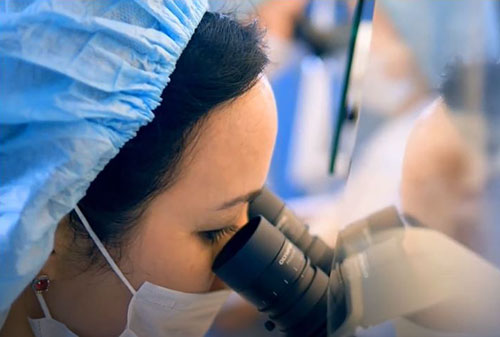
Historically, fluorescence microscopes have been outfitted with metal-halide light source, which contains mercury vapor that can be harmful to human health and the environment. Labs can use less hazardous, more efficient alternatives to mercury-based light sources, such as solid-state illuminators and LEDs.
In addition to enhancing safety, solid-state and LED alternatives reduce plug loads in the laboratory through energy efficiency. Solid-state and LED illuminators also have a longer life span than metal-halide bulbs, reducing the need for intensive disposal processes. Furthermore, LED and solid-state illuminators can be turned on to full brightness at a moment's notice; metal-halide bulbs have to be warmed up for at least 20-30 minutes prior to use, and because of this, are often left on during the entire day, using energy even when not in use.
| Typical Metal-Halide Illuminator | Solid-State or LED Illuminator |
|---|---|
| Contains hazardous mercury vapor | Less hazardous materials used |
| 3-4 kWh/day | 2 kWh/day |
| Lasts 2,000 hours | 20,000 hours |
| 20- to 30-minute warm-up period | 0-minute warm-up period |
| Light intensity degrades over time | Light intensity maintains stability for long periods of time, leading to better quantitative imaging |
Sustainable Procurement
ACT Eco-Label
Laboratories and health care facilities are one of the largest consumers of energy, water, and consumable products. The accountability, consistency, and transparency (ACT) label is an eco-label for laboratory products, including consumables, chemicals, and equipment designed to help guide smarter purchases and reduce the impact of facilities. Designed to resemble a nutrition label, the ACT eco-label provides transparent information about the total environmental impact, from manufacturing to disposal, including:
- Renewable energy use in production
- Packaging impact
- Shipping impact
- Recycled content
- End-of-life disposal impacts.
The ACT program also helps product manufacturers identify opportunities for reducing the impact of products and their packaging materials, as well as their manufacturing and distribution practices, making the reach of the label extend far beyond the product purchase. The ACT eco-label has been recognized by I2SL and the Sustainable Purchasing Leadership Council.
Reading the ACT label is simple: the lower the score, the lower the impact on the environment. Most categories are rated on a scale of one to 10; energy consumption and water consumption are disclosed as kWh/day or gallons/day, respectively. All ACT labels reside on both manufacturer websites and on the My Green Lab ACT website.
Become My Green Lab Certified
Topics presented in the Green Lab Ambassador Program are the core of the My Green Lab Certification, a global certification standard for laboratory sustainability offered by the nonprofit My Green Lab. As part of the Smart Labs initiative, labs are encouraged to become certified.
Steps to becoming certified:
- Take the Baseline Assessment.
Lab members complete an online assessment with questions about laboratory operations. - Receive feedback on opportunities for improvement.
My Green Lab provides feedback to the lab based on baseline assessment results. - Implement recommendations for improvement (six to eight months).
- Complete the Green Lab Ambassador Program (at any time during the six to eight months).
Lab members must watch Smart Science videos, complete the quizzes, and attend the final webinar. - Take the Final Assessment.
Results of the final assessment are used to determine the level of certification for a lab (i.e., bronze, silver, gold, platinum, or green). - Receive feedback on opportunities for further improvement.
- Continue to implement recommendations until the lab is certified as "green," the highest level of certification possible.
Bringing Efficiency to Research Grants
About BETR Grants
Bringing Efficiency to Research (BETR) Grants is an initiative by the University Alliance Group (UAG) that aims to connect efficiency expectations with research funding. The initiative promotes the efficient use of resources to effectively reduce the direct and overhead costs of research and incorporating language about efficiency into grant proposals. This in turn encourages research institutions to move towards creating efficiency programs for labs and bring widespread change in research ethics across the nation. A systematic change towards efficient laboratories will ultimately minimize the environmental and social footprint of research and relieve the pressure of the current competitive funding environment.
Efficiency in Research
Growing participation in BETR Grants among research institutions and non-profit organizations with connections to the research is an important step in showing research sponsors the value of efficiency in critical research facilities. BETR Grants encourages the following practices to enhance efficiency of research practices:
- Sharing research equipment
- Use resources already on campus to minimize funding requested in grant proposals and demonstrate compliance with federal requirements for equipment sharing and avoiding duplication.
- Provide an equipment-sharing platform such as an online tool with inventoried instruments to facilitate researchers in sharing existing equipment, beyond the most expensive instrument.
- Promote a campus-wide culture of equipment sharing. Actively encourage current researchers and include topics of equipment sharing in interviews and offer letters for new faculty and staff.
- Utilizing research space efficiently
- Implementing energy and water efficiency measures
- Incorporating efficiency expectations into the institution's culture through required ethics courses for scientists
- Encouraging lab certifications and assessments that reinforce resource-efficient practices listed above
Make Your Grant Proposal Stand Out
By including specific language about efficient research practices your institution implements in your grant proposal, you increase your chances of attaining essential research funding. Some language, however, has the potential to suggest significant administrative burden to your institution in tracking the cost sharing or specific dollar amounts. This could limit the ability of your institution to negotiate your most beneficial overhead rate with your cognizant federal agency. As such, it is important to carefully consider how you describe your laboratory's efficient practices in your grant proposal.
| Dos and Don'ts of Incorporating Efficient Research Practices in Grant Proposals | |
|---|---|
|
*unless the sponsor or funding opportunity explicitly requires this information for the submission. |
Where Should Language Be Included?
Language could be included in the following:
- "Broader Impacts" section of National Science Foundation proposals
- "Budget Justification" sections
- "Resources and Environment" and/or "Resource Sharing Plans" sections of National Institute of Health proposals
- "Facilities and Other Resources" sections found in many agency proposals (section names may vary between agencies).
